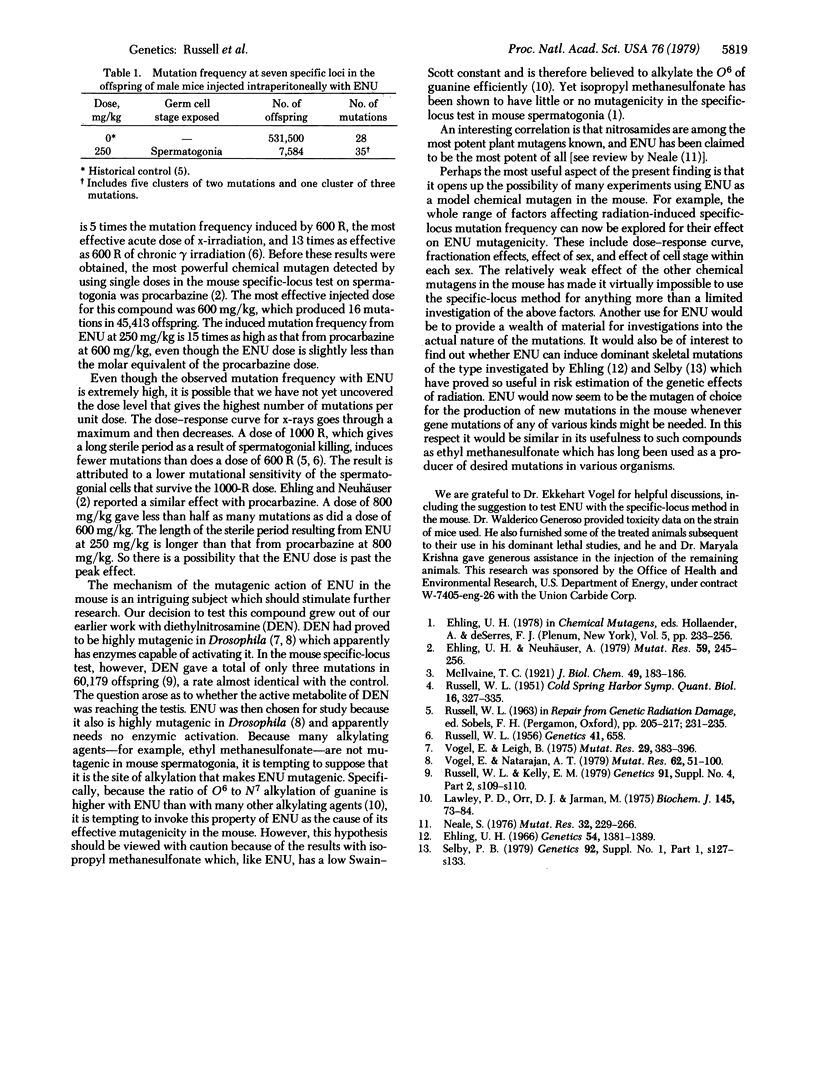Abstract
Use of the specific-locus test to measure the frequency of transmitted gene mutations induced in mouse spermatogonia has shown ethylnitrosourea to be by far the most potent mutagen yet discovered in the mouse. The dose used, 250 mg/kg, gave a mutation rate 5 times as high as had been obtained with 600 R, the most effective acute dose of x-rays. Compared to procarbazine, heretofore the most mutagenic chemical known in the mouse, ethylnitrosourea proved to be 15 times more mutagenic than the peak effect obtained with the most effective dose of procarbazine. Because of its high mutagenicity, ethylnitrosourea can serve as a model compound in exploring the effect of such factors as dose response, dose fractionation, sex, and cell stage on the mutagenic action of a chemical. Ethylnitrosourea is clearly the mutagen of choice for the production of any kind of desired new gene mutations in the mouse.
Full text
PDF

Selected References
These references are in PubMed. This may not be the complete list of references from this article.
- Ehling U. H. Dominant mutations affecting the skeleton in offspring of x-irradiated male mice. Genetics. 1966 Dec;54(6):1381–1389. doi: 10.1093/genetics/54.6.1381. [DOI] [PMC free article] [PubMed] [Google Scholar]
- Ehling U. H., Neuhäuser A. Procarbazine-induced specific-locus mutations in male mice. Mutat Res. 1979 Feb;59(2):245–256. doi: 10.1016/0027-5107(79)90163-5. [DOI] [PubMed] [Google Scholar]
- Lawley P. D., Orr D. J., Jarman M. Isolation and identification of products from alkylation of nucleic acids: ethyl- and isopropyl-purines. Biochem J. 1975 Jan;145(1):73–84. doi: 10.1042/bj1450073. [DOI] [PMC free article] [PubMed] [Google Scholar]
- Neale S. Mutagenicity of nitrosamides and nitrosamidines in micro-organisms and plants. Mutat Res. 1976;32(3-4):229–266. doi: 10.1016/0165-1110(76)90002-6. [DOI] [PubMed] [Google Scholar]
- RUSSELL W. L. X-ray-induced mutations in mice. Cold Spring Harb Symp Quant Biol. 1951;16:327–336. doi: 10.1101/sqb.1951.016.01.024. [DOI] [PubMed] [Google Scholar]
- Selby P. B. Induced skeletal mutations. Genetics. 1979 May;92(1 Pt 1 Suppl):s127–s133. [PubMed] [Google Scholar]
- Vogel E., Leigh B. Concentration-effect studies with MMS, TEB, 2, 4, 6-TriCl-PDMT, and DEN on the induction of dominant and recessive lethals, chromosome loss and translocations in Drosophila sterm. Mutat Res. 1975 Sep;29(3):383–396. doi: 10.1016/0027-5107(75)90059-7. [DOI] [PubMed] [Google Scholar]
- Vogel E., Natarajan A. T. The relation between reaction kinetics and mutagenic action of mono-functional alkylating agents in higher eukaryotic systems. I. Recessive lethal mutations and translocations in Drosophila. Mutat Res. 1979 Aug;62(1):51–100. doi: 10.1016/0027-5107(79)90223-9. [DOI] [PubMed] [Google Scholar]


